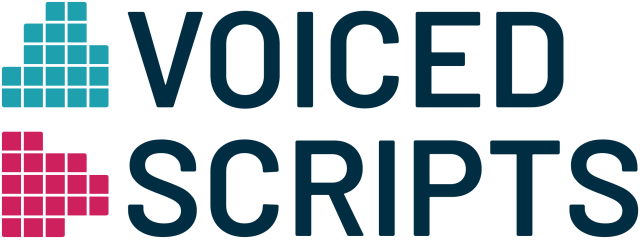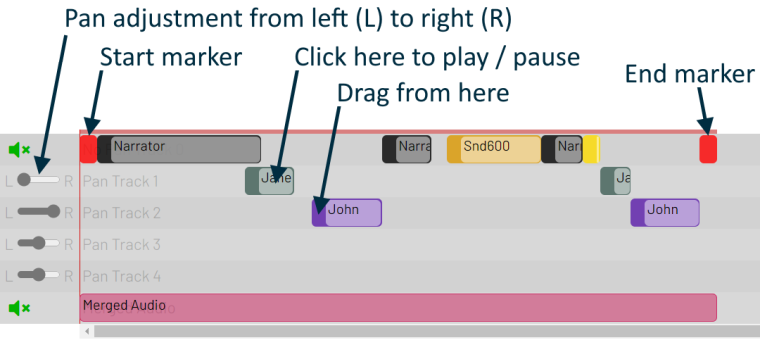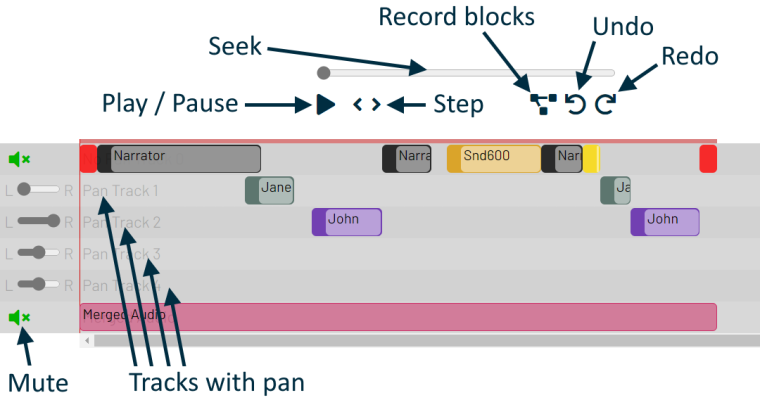
This wizard can help you to quickly create a podcast type mp3 from your voiced scripts audio segments. The app supports four character voices that can be assigned different spatial characteristics (pan settings) plus an infinite number of other voices / sounds on a no pan track. These can then be merged into a single audio, right in your browser, without uploading or downloading any files.
IMPORTANT NOTE: As this is a browser native application, it is very important that you do not navigate away from the page before you have saved your work. You may lose your unsaved work - among other actions - if you enter the address of another web page into the address bar, press the "back-button" of your browser, or close your browser window.
LIMITATIONS: Our software uses technology that is built into latest versions of modern web browsers. It works with Google Chrome (Versions 68+), Microsoft Edge (versions 79+), Firefox (Versions 79+), Opera (Versions 64+), Chrome for Android (Versions 92+), and Firefox for Android (Versions 90+). Internet Explorer, Safari, Safari on iOS, and Opera Mobile browsers are currently not supported.
If you started working on a podcast, saved your changes, but had to quit the app before you could finalize your mp3, you can reload the arrangement of your voiced scripts audio segments to continue from where you left off. Please note, however, that you will have to reload your Audio ZIP-File, since the security settings of your browser do not allow us to access it automatically, even though we know which file it is.
Voiced scripts post-processing files for podcast creation are saved by default with the name "Podcast.vsppp", in any case with the ending ".vsppp", and commonly in your default "Downloads" folder.
Select the Audio ZIP-File of the dialog you want to edit. If you did not download the Audio ZIP-File, you should go back to Your Downloads Page and download the Audio ZIP-File you want to edit. If you deleted your Audio ZIP-File after decompressing it or edited it in some way, you will have to download it again, as our post-processing requires an intact "Voicedscripts ZIP File".
The voiced scripts files you create are stored on our servers for a period of one week. If you failed to save your "Voicedscripts ZIP File" during this time period, you can contact us to request your file to be retrieved from our archive.
The audio segments of your dialog are shown graphically between an unmoveable one second start marker and an unmoveable one second end marker. Each audio segment is color coded based on the character speaking / file being played, and their widths are proportional to the durations of the individual audio segments.

By clicking / tapping on the lighter part of an audio segment, you can play / pause that segment. By dragging an audio segment at the leftmost, darker part, you can move it along the same track, to let characters take turns, to insert a pause, or to let dialogs occur in a simultaneous manner. The app makes sure that subsequent audio segments are rearranged such that the order of speakers in the dialog can never change.
The first four characters of the dialog (not counting the narrator) are automatically arranged on tracks 1 to 4 where you can adjust the pan from all the way LEFT to all the way RIGHT. All other voices are inserted onto track zero with equal left-right pan setting.

In the context of podcast creation, merging dialogs means putting the audio on different tracks into one continuous audio track. When you click / tap play, all audio tracks play along simultaneously. You can mute the dialog segments and the merged audio independent of one another. You can seek or step through key frames (with a maximum resolution of 20 frames per second), to find the exact position where a dialog segment should start.
Having edited starting positions of audio segments, you can optimize and record the arrangement, ready for saving. You can use the "undo" and "redo" buttons in case you have to make corrections.
A unique feature of our post-processing is that your audio is not uploaded to the internet. All processing occurs right in your browser, just like with a software running on your computer, albeit, without the need to install a software. All you need is a modern browser.
While this method of post-processing is very secure and fast, the first time you use the wizard, some software snippets on our server are accessed, so that it may take a while for the app to be ready, depending on your browser version, and your computer and internet connection speeds. In all subsequent operations, the processing will be fast.
Once the audio of all tracks have been merged, you can save the result. As with other downloadable files at our site, the merged audio will be saved in your default "Downloads" folder with a default name (in this case "Podcast.mp3"). If you wish to save the file with a different name or in a different folder, you can right-click on the link and choose "Save link as" to do so.
If you make changes to the arrangement of your voiced scripts audio segments, or change the pan setting of a track, you will have to go through the merging step again before you can save the audio.
This option becomes available as soon as you have optimized and recorded the arrangement of the voiced scripts audio segments. If you have to quit the app before you can finalize your podcast mp3, you should save your changes to continue at another time.
Voiced scripts post-processing files for podcast creation are saved by default with the name "Podcast.vsppp", in any case with the ending ".vsppp", and commonly in your default "Downloads" folder. If you wish to save the file with a different name or in a different folder, you can right-click on the link and choose "Save link as" to do so.